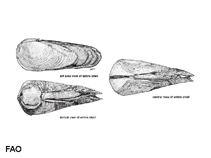Martesia striata (Linnaeus, 1758)
Striate martesiaWarning: DOMDocument::load(): SSL operation failed with code 1. OpenSSL Error messages: error:140770FC:SSL routines:SSL23_GET_SERVER_HELLO:unknown protocol in C:\Apache24\htdocs\includes\SpeciesSummary.lib.php on line 1236
Warning: DOMDocument::load(): Failed to enable crypto in C:\Apache24\htdocs\includes\SpeciesSummary.lib.php on line 1236
Warning: DOMDocument::load(https://sealifebase.nrm.se/webservice/AquaMaps/getAMap.php?genus=Martesia&species=striata): failed to open stream: operation failed in C:\Apache24\htdocs\includes\SpeciesSummary.lib.php on line 1236
Warning: DOMDocument::load(): I/O warning : failed to load external entity "https://sealifebase.nrm.se/webservice/AquaMaps/getAMap.php?genus=Martesia&species=striata" in C:\Apache24\htdocs\includes\SpeciesSummary.lib.php on line 1236
Classification / Names Common names | Synonyms | CoL | ITIS | WoRMS
Bivalvia | Myida | Pholadidae
Environment: milieu / climate zone / depth range / distribution range Ecology
Benthic; depth range 0 - 21 m (Ref. 104365). Tropical
Distribution Countries | FAO areas | Ecosystems | Occurrences | Introductions
Circumglobal distribution in temperate and tropical marine waters.
Length at first maturity / Size / Weight / Age
Maturity: Lm ? range ? - ? cm Max length : 5.0 cm SHL male/unsexed; (Ref. 348); common length : 3.5 cm SHL male/unsexed; (Ref. 348)
Found in intertidal areas and shallow water in timber (Ref. 75831). Wood borer (Ref. 104365). Also found boring in PVC plastic (Ref. 75840).
Life cycle and mating behavior Maturity | Reproduction | Spawning | Eggs | Fecundity | Larvae
Alternating hermaphrodite changing sex with temperature, most individuals becoming female in summer and male in winter. Fertilization external. Free-swimming larval stage of about a month.
Main reference
References | Coordinator | Collaborators
Poutiers, J.M. 1998. (Ref. 348)
IUCN Red List Status (Ref. 130435)
CITES status (Ref. 108899)
Not Evaluated
CMS (Ref. 116361)
Not Evaluated
Threat to humans
Human uses
| FishSource |
Tools
More information
Internet sources
BHL | BOLD Systems | CISTI | DiscoverLife | FAO(Publication : search) | Fishipedia | GenBank (genome, nucleotide) | GloBI | Gomexsi | Google Books | Google Scholar | Google | PubMed | Tree of Life | Wikipedia (Go, Search) | Zoological Record
Estimates based on models
Preferred temperature
(Ref. 115969): 23.3 - 29.2, mean 28 (based on 4327 cells).
Price category
(Ref. 80766):
Unknown.



